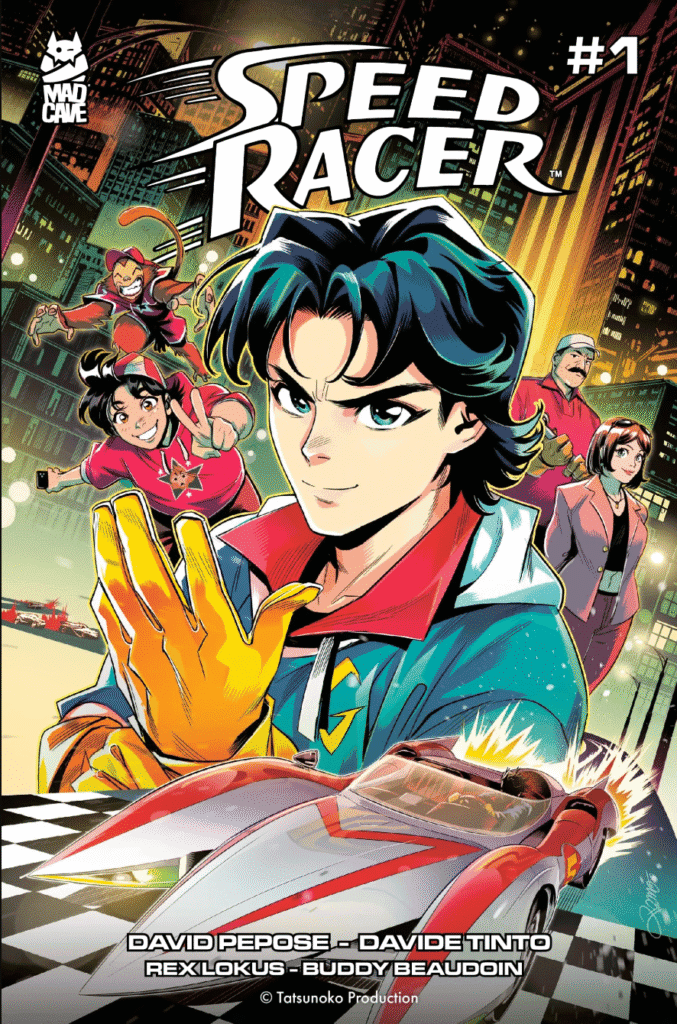Speed Racer #1
Recap
An all-new interpretation of Tatsuo Yoshida’s classic manga/anime, MachGoGoGo, known to Western audiences as Speed Racer! Speed Racer lives for the thrill of the race, but on the underground circuit, the rules are anything goes. Dodging bullets, explosions, and dirty tricks, he’s got one goal: to prove he’s the best. But when a dangerous syndicate targets his family, Speed’s greatest challenge won’t be on the track…it’ll be on the streets. With the police closing in and a masked racer lurking in the shadows, Speed is about to learn that some races can’t be won with horsepower alone. Award-winning writer DAVID PEPOSE (Space Ghost, Captain Planet, Savage Avengers) and superstar artist DAVIDE TINTO (Ultraman: The Mystery of the Ultraseven, Star Wars: Bounty Hunters) co-pilot an action-packed reboot of the classic franchise. Start your engines!
Review
He’s back. Speed and his trusty Mach 5 race into a brand new series. And when you’ve got a character as storied as Speed is, there is pressure to get him right. A whole new creative team sets out to do just that in the new Speed Racer #1.
Speed Racer #1 is an exposition heavy first issue. But it’s also character centric so they end up delivering that exposition. Pepose avoids info-dumping monologues, dropping backstory via emotion based conversations. A prime example of this is Speed and his father where Pepose both establishes key family history and showcases a growing rift between the two characters. But a byproduct of this method of delivering exposition is that the dialogue is a bit clunky at times. Pepose never goes full “Remember that time when we did…”, but it occasionally interrupts the tension in a scene.
This sometimes difficult dialogue doesn’t take away from the overall character development in Speed Racer #1, though–especially when it comes to Speed and his father. Character based storytelling is usually Pepose’s strong suit, and that is the case here. Indeed, the nuts and bolts plot is barebones, and yet there is never the sense that the issue is lacking substance.
The very important benefit of the character based exposition in Speed Racer #1 is that the issue is accessible to all readers. It also gives the reader someone to root for beyond just seeing the characters as devices to carry the plot forward.
Pepose’s effective character writing is supported and enhanced by Tinto’s overall art style. Tinto makes no attempt to lean into Speed Racer’s manga origins with generally broad, if not overly exaggerated, facial expressions. Thin, short, light lines accentuate characters’ facial features, and this added detail keeps their expressions grounded. Even so, Tinto’s level of detail is conservative on the younger characters with more liberal line use only when they get emotional.
A good example of how Tinto handles characters is the scene where Speed argues with his father. Lines around the edge of his father’s face and forehead emphasize his age, but when the two argue, Tinto adds even more lines to highlight the character’s cheekbones and jaw line. Speed, on the other hand, is comparatively light on facial details which gives his face a softness of youth. When he gets emotional, though, Tinto goes heavier with lines to show that emotion.
Very importantly in a series focused on racing and speed, Tinto emphasizes movement and power with straight and comparatively thick lines. They are used most often around the Mach 5 and any other cars involved in a race. But they can also be found in explosions and other intense visual moments. Tinto makes Speed Racer #1 feel fast from first page to last.
Color choices in Speed Racer #1 lean toward brighter shades, but the characters and the Mach 5 always go a little further in that direction than their surroundings. They always draw the eye toward them and pop off the page.
Contrasting this are the flashback scenes featuring Rex. Backgrounds have a tan tint to them and while the more colorful characters still pop off the page relative to the background, they are heavily muted compared to the present day scenes.
Beaudoin has a variety of caption and speech bubbles to deal with in Speed Racer #1, from regular dialogue to captions that are specific to characters to PA announcers. Ultimately it’s the smallest details that are the most successful. During an opening race sequence, small caption boxes identify different parts of the Mach 5. Beaudoin chooses blue and gently transitions from a slightly darker at the top of the box to a lighter shade in the middle and back to the darker at the bottom. The captions themselves are small and don’t intrude on anything else on the page. But because of the choice of blues Beaudoin makes, the boxes always stand out.
Final Thoughts
Speed Racer (MachGoGoGo) has a long history, not least because it was accessible in the United States when manga and anime were not yet widely so. If Speed Racer #1 is any indication, the creative team plans to deliver a fresh and modern American comic book take on past characters and concepts. The result is that this Speed Racer is an exciting comic that everyone can enjoy.
Speed Racer #1: Start Your Engines
- Writing - 7/107/10
- Storyline - 8/108/10
- Art - 7.8/107.8/10
- Color - 7.7/107.7/10
- Cover Art - 8.5/108.5/10
